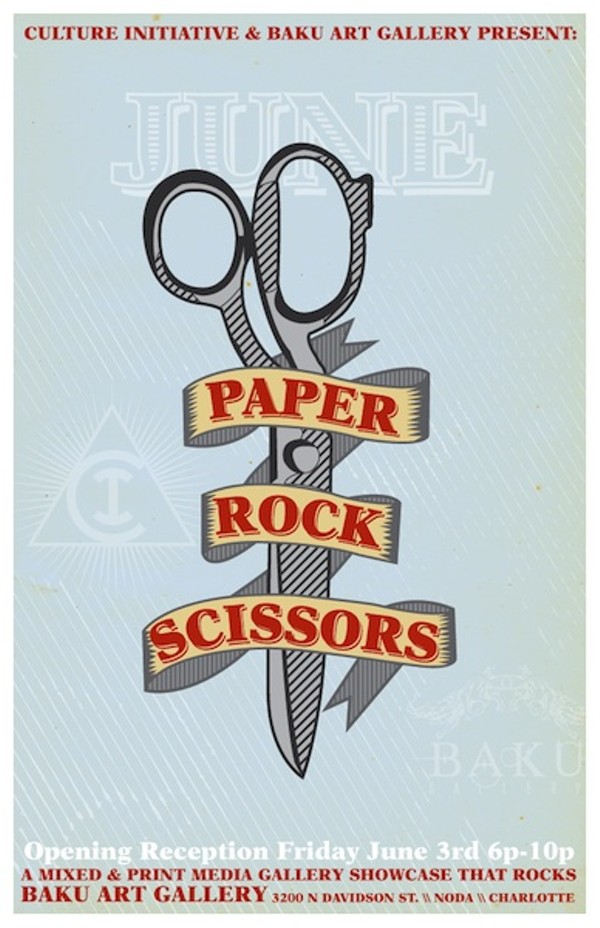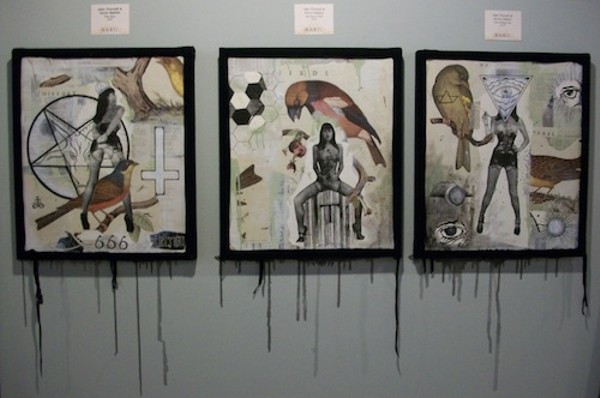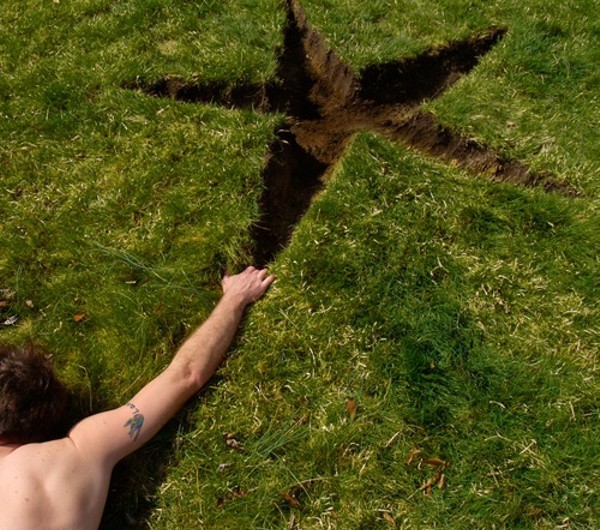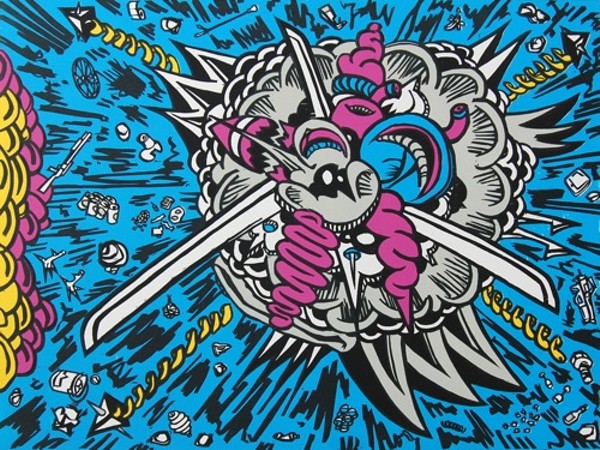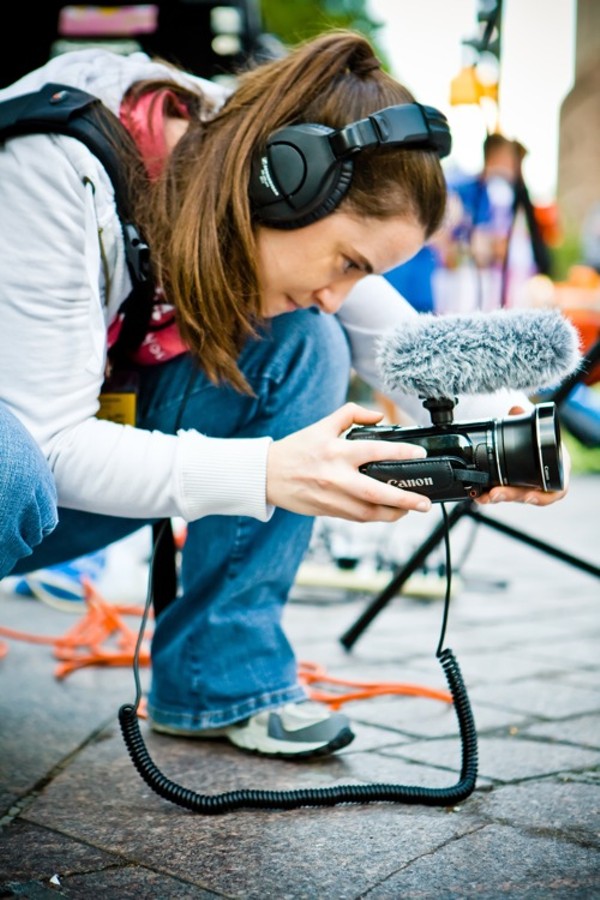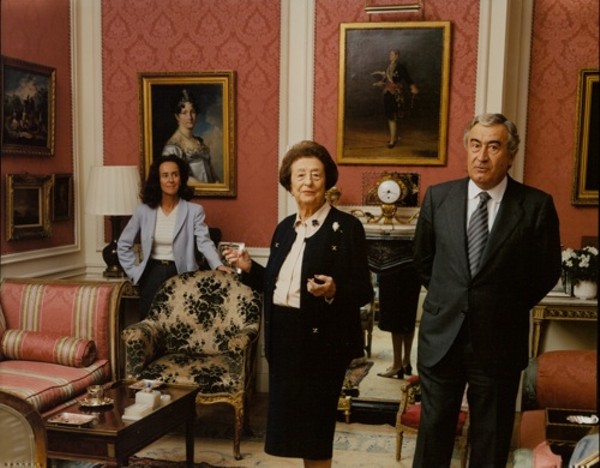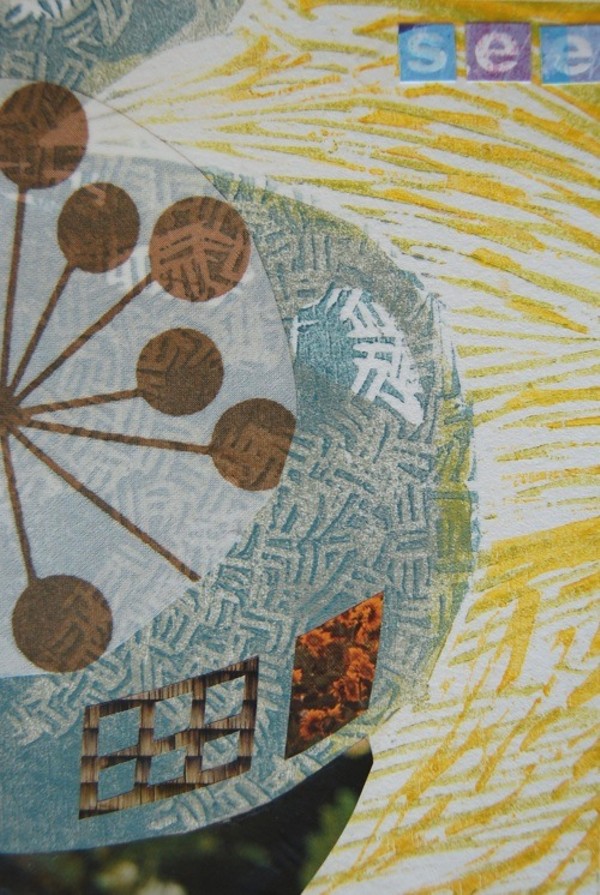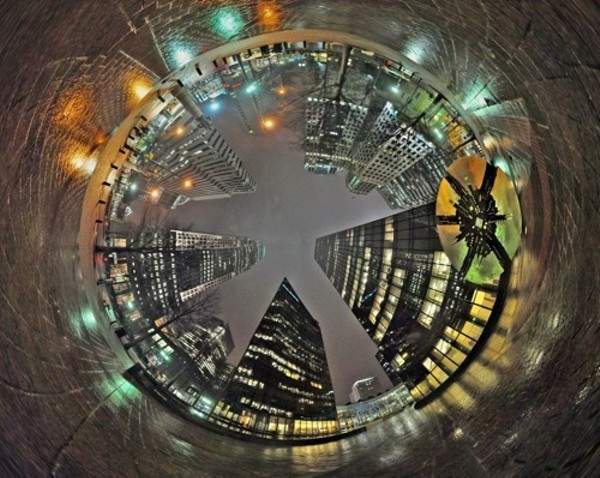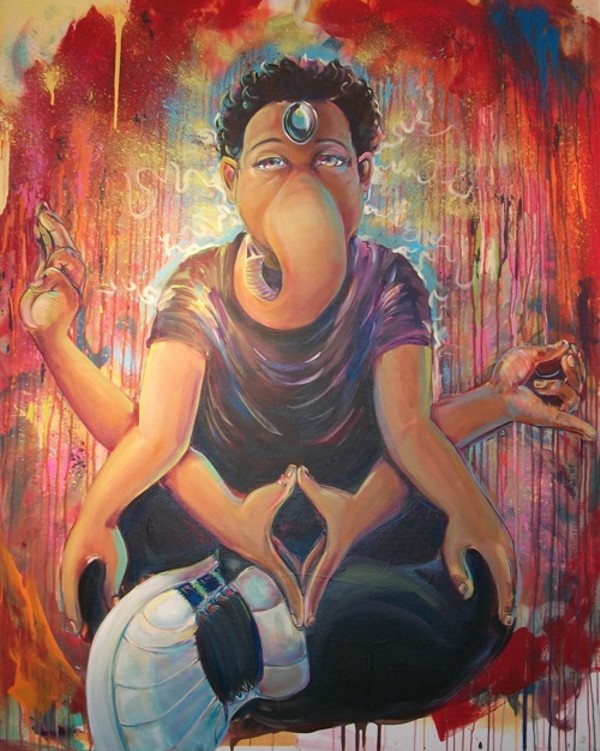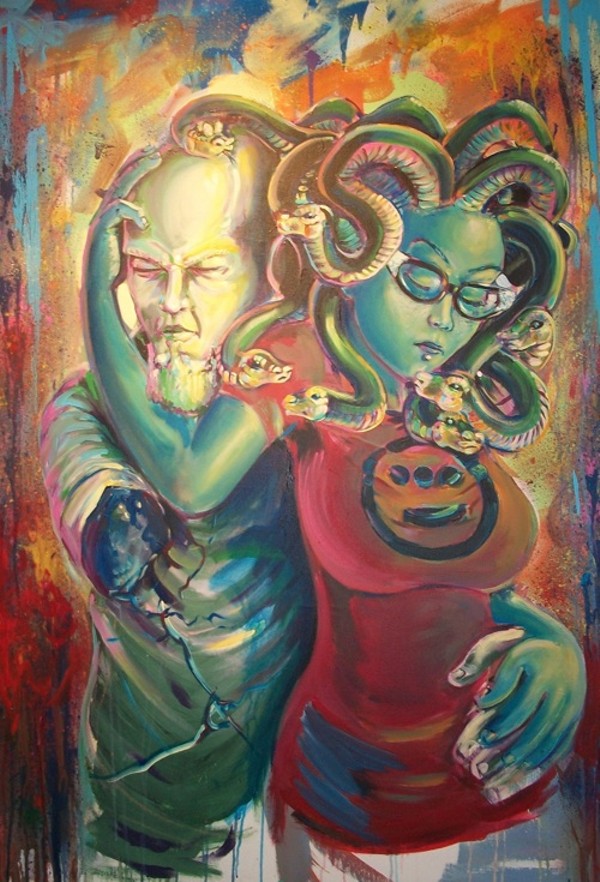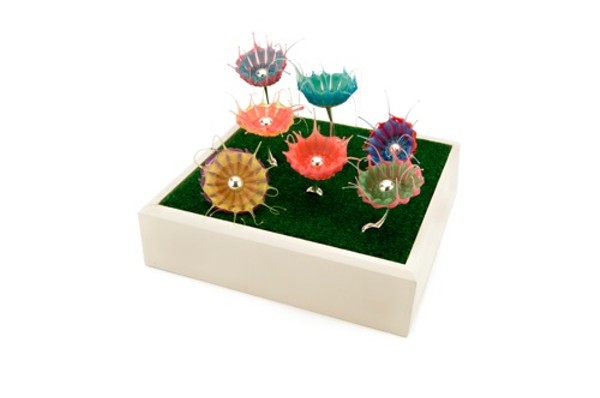Monday, October 24, 2011
Visual Art / Events / Architecture Object lessons
Posted By Barbara Schreiber on Mon, Oct 24, 2011 at 2:45 PM
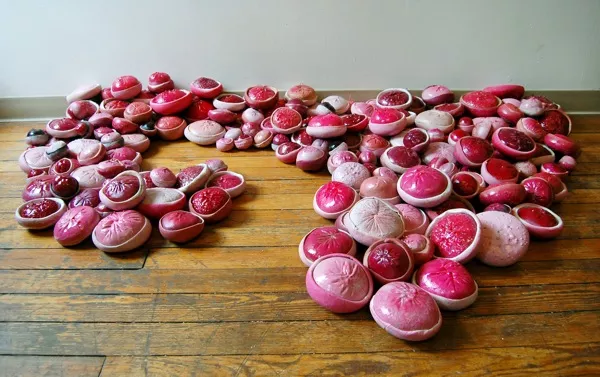
- Photo courtesy of McColl Center for Visual Art
- "Corpuscles" by Carrie Becker, part of the Elements exhibit
By Barbara Schreiber
Incorporating recycled materials, installations large and small, and wearables that challenge the idea of wearability, several current exhibitions pretty much run the gamut of three dimensional art.
In Elements at McColl Center for Visual Art, Michael Gayk and Carrie Becker deal with the organic and the cellular. Although Gayk’s work could accurately be called jewelry and Becker’s soft sculpture, these innocuous labels don’t begin to describe the bold content.
Gayk combines 3-D printing and other current technology with traditional craft. He's at his best here in a sequence of bracelets that, viewed from left to right on the gallery wall, mutate from sleek design to something you might see under an electron microscope, to pieces that look like sentient beings capable of inflicting harm. Even though produced over a period of several years, these controlled works have a hyper-focused consistency.
Tuesday, September 13, 2011
Visual Art / Events Meet the neighbors at UNC Charlotte
Posted By Barbara Schreiber on Tue, Sep 13, 2011 at 4:21 PM
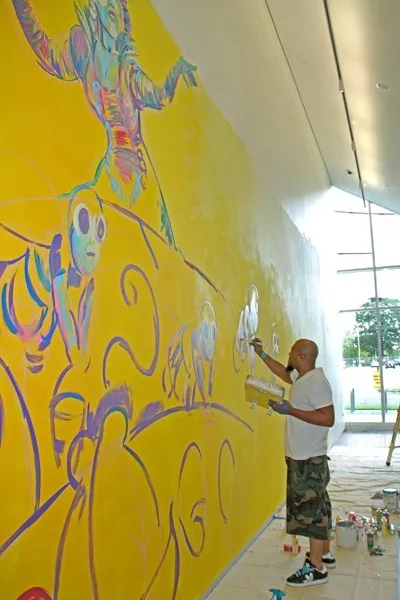
- Crista Cammaroto
- John Hairston working on the mural "Rhymes for Reason"
Festival season is in full swing, but if you’re looking for a tad more artistic gravitas this weekend, stop by the UNC Charlotte Center City Building for its Open House and Community Day on Sept. 17.
Although the gleaming new Uptown campus is home to myriad programs in business, health and human services, urban design, urban education and continuing education, the light-flooded gallery, which has its own entrance on Ninth Street, is one of the more visible aspects of the building. I’ll be writing more about the gallery and its programming later, but let’s just say there are some parallels between it and Saturday’s family friendly goings-on.
Thursday, July 28, 2011
Visual Art Art in a cart: Mobile Art Studio for Creative Disruption
Posted By Barbara Schreiber on Thu, Jul 28, 2011 at 12:07 PM
Since New Englander Diana Arvanites arrived here in 2007, she and the South have been an uneasy match, so it was a surprise when she decided to debut her Mobile Art Studio for Creative Disruption (MASCD) in the middle of a brutal Southern summer.
Starting on June 17, Arvanites has been wheeling her shopping cart/workspace through the metro area, bringing art to people in a way that is direct and disarming. The cart is stocked with supplies and has multiple work surfaces, so several people can draw or paint at the same time, resulting in an intimate art-making experience. So far, MASCD has visited Freedom Park, Villa Heights and Kerr Street in Concord, as well as NoDa, were Arvanites set up shop on the same night Green Rice, one of the neighborhood’s last galleries, was closing.
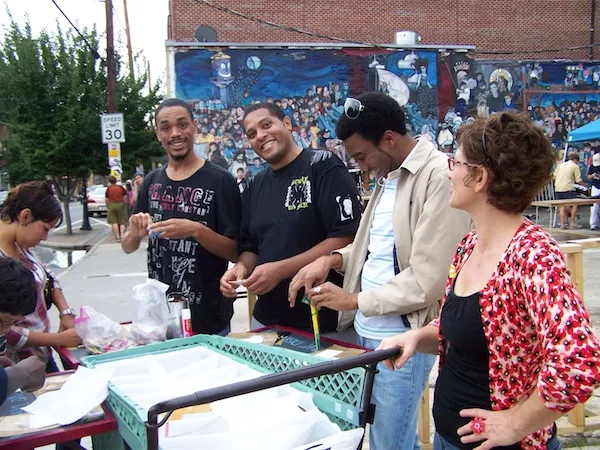
- Photo courtesy of Diana Arvanites
- Diana Arvanites (right) with her Mobile Art Studio for Creative Disruption in NoDa, July 15, 2011
In her role as a citizen artist, Arvanites seeks to make art accessible without dumbing it down or making it sappy. In devising MASCD, she was inspired by the influential artist Joseph Beuys and his promotion of the idea of "social sculpture" — that is, a work of art that can potentially transform society. She built MASCD in collaboration with her partner, Marc Leclair, whom she describes as “an engineer, gadgeteer and electronics geek.”
MASCD is intentionally uncertain and spontaneous — “on an anti-schedule,” Arvanites says. She decides on a destination perhaps a few days in advance, and because the settings vary widely no two experiences are ever the same.
While MASCD is by design impromptu, there might be some long-term planning in Arvanites’ future. She would like to do residencies in other parts of the country for the purpose of building and deploying more carts and is also considering converting a motor vehicle into a studio.
For all of the philosophical and political intent behind the Mobile Art Studio for Creative Disruption, there is a pleasing simplicity to it. “I can’t believe how happy this project makes people,” says Arvanities. “People just don't get enough art.”
Monday, June 27, 2011
Visual Art Exhibit: Paper, Rock, Scissors
Posted By Jeff Taylor on Mon, Jun 27, 2011 at 12:49 PM
Joel Tracey and Arthur Brouthers founded Culture Initiative two years ago to try and inject more enthusiasm and energy into the Charlotte art scene. Tracey tells me that their latest show, Paper, Rock, Scissors, aims to shake up the traditional gallery going experience.
“Visitors can expect to be presented with photography and screen prints framed in a manner not seen in staid galleries around the area,” Tracey explains.
The artists were given the task of representing rock 'n' roll, and the rock 'n' roll lifestyle, through their work. It was, according to Tracey, a show both he and co-founder Arthur Brouthers have been envisioning since starting Culture Initiative two years ago.
It’s clear that some of the artists took the theme to heart much more literally, such as John Kurc’s expertly shot black-and-white photographs of famous musicians like Flea, Dave Navarro and Damon Albarn. Others were more interested in simply creating works with an irreverent or messy feel.
The best of these were Jake Thorsell and Kevin Markie’s three pieces, featuring pentagons, upside down crosses, women in lingerie and, for good measure, colorful birds. Each one looks fit for an album cover. The most perplexing were printmaker John Pundt’s contributions. I’m still trying to figure out what cupcakes, the Boy Scouts and Mickey Mouse have to do with rock 'n' roll, although it’s entirely possible they’re meant to be enjoyed ironically.
Matt Hooker’s ode to heroin-addicted musicians stands as the most notable use of the space as more than just a white walled, run of the mill gallery. It was also one of the more creative interpretations of the show’s theme.
Two white horses — “horse” being a slang term for heroin — are outlined in black, creating an appropriate juxtaposition for such a seductive yet deadly substance. The horses, which are made of wood and affixed to the wall, are surrounded by small portraits of artists like Ray Charles, John Frusciante, and Keith Richards. Each one is framed by bent spoons.
Paper, Rock, Scissors, like most group shows, is a mixed bag. Thankfully, it’s not simply a collection of paintings of rock stars, although there are a fair number of those. And while it may not be as revolutionary as it wishes, it does offer a quick and powerful shot of attention grabbing imagery.
If Paper, Rock, Scissors had to be placed in a musical context, one wouldn’t call it a rock opera. But it’s probably fair to say it’s a damn good single.
Paper, Rock, Scissors is on display at the Baku Gallery, which is connected to Fu’s Custom Tattoo, through June 28th.
Tuesday, May 17, 2011
Visual Art Core Visual Art opens its inaugural gallery exhibition
Posted By Barbara Schreiber on Tue, May 17, 2011 at 2:08 PM
Composed of former McColl Center for Visual Art affiliate artists, Core represents a longtime dream of Center Executive Director Suzanne Fetscher to provide alumni artists opportunities for exhibitions and career development once they leave McColl. Obviously this is a great benefit to Center alumni, but the project has an additional objective that should get the attention of every other artist in the area: to further promote and cultivate new audiences for contemporary art in Charlotte. This is something we desperately need, as the local art community’s chronic invisibility has only worsened as galleries have closed or gone into consultancy mode in the last few years.
The founding Core artists are Raed Al-Rawi, Daniel Allegrucci, Crista Cammaroto, Alex Clark, Diane Hughes, Ashley Lathe, Laura Alma McCarthy and Felicia van Bork. This initial group has been working over the past year refining Core’s vision, writing bylaws, developing a website and dealing with the myriad nuts and bolts of starting an organization.
At the moment, Core is nomadic, although the intention is to eventually secure a permanent space. Luckily one of Core’s founding members, photographer Diane Hughes, is also an independent curator, so this inaugural show will take place at her Ayrsley-area space, Hughes Gallery.
Core is already participating in McColl’s 7th Street Windows project, which has turned out to be even more beneficial than anticipated. Since there are more members than windows, it has been necessary to pair up and work collaboratively. “The windows have provided us the opportunity to develop a way of working together and develop a group identity,” says McCarthy. “As a result, some of us are now working collaboratively on other projects, and others have returned to their work with a fresh perspective.”
Core: The Beginning, Hughes Gallery, 2015 Ayrsley Town Blvd, Charlotte. Opening reception, May 20, 6:00-9:00 p.m., viewing by appointment only through June 17; call Diane Hughes, 704-492-9934. corevisualart.org
Wednesday, May 11, 2011
Film / Performance Art BUSK! — an exploration of Charlotte’s street art culture
Posted By Jeff Taylor on Wed, May 11, 2011 at 11:44 AM
April Denée describes herself as the type to stop an interesting-looking person on the street and ask them about their story.
It’s a trait that no doubt helped her as a freelance journalist. It has now brought her to the unexpected path of writing and directing a feature-length documentary, titled BUSK!; it explores the importance of encouraging street art and performance as a vital part of a city’s cultural health and vitality.
Filmmaking may be a new passion of Denée’s, but it is starting to take precedence over her other endeavors. “Give me a meager salary — just enough to live on — put a camera in my hand, stick me in a room with my editing suite, and let me be happy. It’s that simple,” she states with obvious determination.
The BUSK! website describes the project as “…a character-driven documentary about how a small, emerging city can — and should — encourage street art and performance toward its own social, cultural, and economic growth.”
Charlotte has a sometimes tenuous relationship with its budding music and arts community. Never more so than when that art or music is presented outdoors, free from galleries or commercially backed and publicly sanctioned amphitheaters and performance centers.
The issue is heating up as of late, with proposed changes to the noise ordinance that left many musicians, small business owners and fans of live music up in arms — taking to Facebook and online petitions to vent their frustration and propose softer revisions. The proposed changes have now been scrapped and the second, revised proposal is still being debated.
Not content to simply make a film, Denée also organized an Uptown busking event called Buskapalooza last week. The idea was to both raise awareness of Charlotte buskers and the ongoing BUSK! fundraising campaign.
A grant from the N.C. Arts Council has covered some of the necessary funding for the project, but supporters of the project can also make donations via the film’s IndieGoGo page to help finance the film in time for an expected December premiere here in Charlotte. Rewards are available to funders, with different incentives for various donation levels.
Buskapalooza was intended to be a one-off event, but it now looks like it could become a Charlotte staple. “The event was so successful that, even before it was over, people were asking when we were going to have the next one,” says Denée. “I'm already in talks to host another Buskapalooza this summer, so if anyone missed the first event, I hope they can make it to the second. And even if they can't manage that, they'll be able to see Buskapalooza footage on the big screen once the documentary is completed, since the event was documented as part of the film.”
While she’s clearly excited about the possibility of another Buskapalooza, she hopes Charlotte musicians won’t wait around for an excuse to get out there and share their art. She’s confident in the likelihood of that outcome, saying, “I can at least say that the buskers who participated in the event last Friday are now more comfortable to go out and busk on their own, having learned about and experienced first-hand the busking-related laws we discussed as part of event preparation and that appear on the backs of their Buskapalooza event badges.”
Watch the recently released BUSK! trailer below, and check out those aforementioned busking laws if it moves you to take to the streets with instrument in hand.
BUSK! (documentary trailer) - street art & performance, grassroots creative culture from April Denée on Vimeo.
Tuesday, May 3, 2011
Visual Art A new space, a last chance: exhibitions at The Light Factory and Gaines Brown Gallery
Posted By Barbara Schreiber on Tue, May 3, 2011 at 2:50 PM
In the next few days, catch some shows before they close, and see a new space.
LAST CHANCE: You have until May 15 to see two noteworthy photography shows at The Light Factory — Body & Soul in the Middleton McMillian Gallery and Bring the Family in the Knight Gallery.
Body & Soul, an understated meditation on the human body, features work by Joyce Tenneson, Jock Sturges and Mona Kuhn.
Sturges, who often photographs on nude beaches, is represented by Fanny, Montalivet, France, a series of gelatin silver prints taken between 1991 and 2009 that depict a girl’s transition to womanhood. Sturges is periodically harassed by religious conservatives who misrepresent his work, but the images here are not at all salacious. Rather than being exploited, Fanny appears very much in control of the image and her relationship with the photographer. Tenneson’s archival digital prints have an ethereal, pre-Raphaelite feel, and Kuhn’s chromogenic prints of figures and the rainforest document her yearnings for the Brazil of her childhood.
Although The Light Factory had to cover the glass door and post a content warning for Body & Soul, the show is actually soothing and introspective. In contrast, Bring the Family, with work by Tina Barney, Catalina Kulczar-Marin, Lydia Panas and Natalie Young, is far more knotty in its depictions of complex relationships.
Barney’s gorgeous, large chromogenic prints show affluent people at home. Barney photographs what she knows; this is her milieu. Her work delves into a world in which both things and decorum matter; people are stiffly arrayed among their possessions, and every object in a room seems fraught with significance. In The Mark of Abel, Panas’ series of prints, family groups in halcyon settings stare at you in a way that flips the relationship between viewer and image. Kulczar-Marin’s Let Love Reign, a series of digital C-prints, are tender portraits of same-sex couples that show the affectionate ordinariness of their relationships. Young’s gelatin silver prints of pets and her husband’s parents on their farm present yet another example of a created family as an alternative the family into which one is born.
Body & Soul and Bring the Family, through May 15 at The Light Factory, 345 N. College Street. www.lightfactory.org/photography.
NEW SPACE IN SOUTH END: Gaines Brown Gallery, a new (and I hope, continuing) venture, will open May 6 with TransFUSION, an exhibition by Charlotte Artery. South End pioneer Gaines Brown, an exhibit designer and artist who has long been committed to making the area an intimate and vibrant destination, has been converting part of his business into a gallery space and is testing the waters with this show.
I saw the gallery in transition — the exhibition had not yet been installed and modifications were still underway — but you could easily see the great potential of this large, bright space. Brown’s enthusiasm about the possibility of providing a much-needed venue for local artists is palpable.
TransFUSION includes new work by Artery members Julie Benda, Janet Lasher, Ashley Lathe, Bev Nagy, Sharon Dowell, Teresa Hollmeyer, Paul Keysar and Jon Tarleton and guest artists Cher Cosper, Allison Luce, Isaac Payne and Terry Shipley.
Charlotte Artery: TransFUSION, Gaines Brown Gallery, 1520 S Tryon St. Opening reception, May 6, 6:00-9:00 p.m. Closing reception, June 3, 6:00-9:00 p.m. charlotteartery.com.
Wednesday, March 23, 2011
Visual Art Last chance to enter The Darkroom
Posted By Jeff Taylor on Wed, Mar 23, 2011 at 3:33 PM
Twenty-Two has become one of the more interesting spots in Plaza Midwood over the past couple of years. The bar/gallery continues to show some of the most exciting local art and its current photography exhibition is no exception.
Six Charlotte based photographers are displaying their work against Twenty-Two's newly painted black walls, and the timing couldn’t be better for the establishment’s updated look. It also gives more poignancy to the exhibit’s title, The Darkroom, though perhaps that’s merely a coincidence.
Dylan Chorneau, Richie McCorkle, Micah McSwain, Kenny Owens, Myk Pate, and Kevin Womack all have distinctive styles, yet The Darkroom feels anything but scattershot or incoherent. It is held together in part by the common thread of featuring local people and places, many of which come not only from Charlotte but from the Plaza Midwood neighborhood itself.
Kenny Owens comes from the film world but it’s clear that he’s having no trouble translating his eye to still photography. Many of his pictures contain motion and a cinematic, scene-like feel that make them appear as if they’re movie stills. His work bares a slight resemblance to Ryan McGinley and Brandon Herman’s work, though he admitted to not having heard of either and cited fashion photographer Terry Richardson as his main non-filmmaker influence.
Myk Pate’s contributions have a more glossy and flashy feel. His works appear as if they have been ripped from the pages of entertainment magazines. They grab your attention and made me think that this is what Larry Clark’s work might look like if he were a bigger fan of color and the more exuberant side of debauchery.
Micah McSwain and Richie McCorkle take a street photography approach. McSwain’s work most often centers around the detritus found on the street itself. The black and white photos present rust, decay and various debris in intimate close ups that allow the viewer to look at these usually unloved items as something worthy of careful and loving inspection.
McCorkle is showing work dating as far back as ’96, and extending to this year. His work focuses on street scenes; mostly skaters pulling off tricks or just hanging out. Fittingly, he is donating a portion of the proceeds from the sale of his work to the “Let The Good Times Roll” skate park project.
Dylan Chorneau’s black-and-white portraits are among the most calm and focused compositions in the show. Shadow and obscurity play a big role in many of the pieces. Even when we can see the subjects’ faces they remain expressionless, giving nothing away.
Finally, Kevin Womack presents unique pieces which left me lingering and scratching my head, curious as to how he’s managed to create these surreal images. There are a couple straightforward pictures, and one tilt-shift photo, but the ones that are most accomplished and noteworthy are his stereographs. Womack explained to CLT Blog that he shoots multiple overlapped photographs by hand, usually about 10 to 45 for each individual stereograph, and then stitches them all together. He then morphs and stretches the stitched panoramic until he arrives at the desired final image. The result is wholly unusual and technically impressive. It’s the city and surrounding neighborhoods as seen through a distorting vortex. Womack has informally dubbed this series "Planet Charlotte," and for me they were the highlight of an already impressive show.
The Darkroom will be on display through March 26 at Twenty-Two (1500 Central Avenue).
Wednesday, March 16, 2011
Visual Art Art review: John Hairston Jr's Here's What's Left ...
Posted By Jeff Taylor on Wed, Mar 16, 2011 at 3:15 PM
John Hairston Jr.’s latest solo exhibition, Here’s What’s Left…, is a collection of works created over the past year. Most have never been shown in Charlotte until now, although they have made their way through much of the rest of the Southeast (Charleston, Atlanta and Columbia, to name a few). The paintings are on display throughout the month at Espada Bicycles in NoDa.
Hairston’s work is instantly recognizable. His colorful and often unpredictable palette, combined with his use of recurring characters, create a signature style that has helped him maintain a large following in recent years. Fellow Charlotte artist Thomas Michael (aka “UGLY”) insists that there are more than a few local artists pushing themselves to new heights simply in an attempt to catch up to Hairston’s talent.
There are several pieces in the show featuring one of his most recurrent characters, a Medusa haired woman (and in one painting a girl) named Magdelene, after the artist’s grandmother. When I expressed surprise that he’d name the man-eating character after his grandma, he corrected me, saying she wasn’t a man-eater. Instead, he claims, she’s just misunderstood. “She’s just a really pretty girl with a shit ton of baggage, and everyone knows somebody like that.”
One of the most intriguing and captivating paintings on display features the artist embracing Magdelene from behind with the one arm he has left. The other has been amputated, and apparently recently so as there appears to be blood and tendons still spewing from the open wound. The title, “My path of destruction was nothing by comparison…,” adds some context while maintaining a certain extent of ambiguity. This guarded illumination shows up in several of the paintings, in fact.
The work in Here’s What’s Left… draws from and pays homage to a rather disparate collection of influences; be it from Greek mythology (the aforementioned Magdelene character), Eastern religions (elephant heads, third eyes and multiple arms make several appearances), or personal heroes, such as the recently deceased artist and musician Rammellzee. Hairston created the piece “Once they were up, they had better be ready to fly…” as a way of saying goodbye to and letting go of an icon whose passing put an end to his dream of one day speaking with him and picking his brain for the many pieces of wisdom contained within.
Some viewers may find themselves somewhat overwhelmed by the colliding cultural, mythological and religious pulls, which are at times presented collage-like in a single work. To say nothing of the attention grabbing vibrancy of the comic book style figures often found boldly populating the canvases. But it’s next to impossible to be underwhelmed by what Hairston creates, and it’s clear that these same attributes are what attracts those who appreciate the work. It’s a group that continues to grow, and the prolific artist shows no signs of slowing down anytime soon.
Wednesday, March 9, 2011
Visual Art RubberMADE: Courtney Starrett’s jewelry is beautiful, funny and just a bit menacing
Posted By Barbara Schreiber on Wed, Mar 9, 2011 at 12:02 PM
RubberMADE, Courtney Starrett’s current exhibition at the Winthrop University Galleries, is a collection of colorful necklaces, brooches, bracelets and rings that are inspired by the exuberance and optimism of the American consumer in the 1950s and early '60s, but also hint at the discord and disarray to come. Numerous aspects of the show — the materials, the titles, the visual references — are faithful to the era. Made primarily from silicone rubber, many of these pliable, jittery baubles can easily double as sculpture.
Most of the pieces are exhibited on custom-made plexi display forms — torsos and hands that are clearly inspired by magazine ads. The forms are slightly smaller than life size, so the jewelry dominates them. But these plexi ladies are so perky that they seem oblivious to the fact that they are almost being consumed by their adornments.
The individual pieces are titled with advertising slogans, with results ranging from the appealing ("It Doesn’t Take an Expert to Grow a Beautiful Garden" pairs somewhat innocently with a set of flower rings embedded in a box of Astroturf.) to the ominous. ("The Sociable Choice" is a bracelet that looks like a sea anemone.)
There are myriad visual sources including spaceships and food, but my personal favorite is the sticky, icky and threatening. The show abounds with tentacled objects that look like the spawn of predatory sea creatures and flowers, creating an alternate world in which smiling women happily attach suspicious life-forms to their bodies.
Complementing the jewelry is a wall installation consisting of vinyl strips with text and silicone flower forms mounted with upholstery tacks and powder-coated washers. Here again, Starrett begins with something conventional — cheery patterned wallpaper — and takes it in a different direction with her three-dimensional sci-fi flowers. Spread across a large expanse of wall in the boxy gallery, it is sprightly and charming. I would love to see this same installation in a more constricted space, where I think it would take on the slightly unnerving tone that Starrett brings to the rest of her work.
Courtney Starrett: RubberMADE is on exhibit at the Elizabeth Dunlap Patrick Gallery, Winthrop University Galleries, Rock Hill S.C., through March 25.


